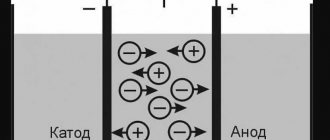In order to understand how high-quality voltage is supplied to our outlet, two things are needed - to know the quality standards and to know how to measure these standards. In this article I will tell you in detail what voltage quality is and how to measure its characteristics. This will not be a theoretical Wikipedia article, but material as close as possible to real life.
Let's see what we can measure and see in reality in the power supply network. I will provide official quality standards and show what can actually happen on the network.
How and why to evaluate the quality of voltage in the network?
Really, why? After all, all you have to do is press a button on the TV remote control or plug your iPhone charger into a power outlet and enjoy the benefits of electrification throughout the country!
But there are times when something goes wrong: the crocodile is not caught, the iPhone does not charge, the air conditioner produces a strained hum instead of coolness, and the TV shows no signs of life after a click.
Knowledgeable people have gathered here who understand that the values of the main parameters of the electrical network - voltage and frequency - can be found out primarily using a multimeter. But what to do if you need to see what is happening in the outlet during the day? But what if you need to track a voltage surge that is much shorter in time than the multimeter measurement interval? Moreover, it may be that the time of appearance of this artifact is unknown.
Usually, for any voltage problems, stabilizers are installed, but they do not always help. After all, the stabilizer eliminates the effect, but not the cause of the problem. And if there is an abrupt short-term change in voltage, then the stabilizer will not only not help, but will also worsen the situation.
And in order to understand what to do in this or that case - check the quality of the contacts at the input or install a stabilizer - you need a Power Quality Analyzer.
A power quality analyzer provides a complete picture of what is happening at the outlet.
In my work I use the HIOKI 3197 electrical energy quality analyzer, photos of which will be given in the article.
Without a quality analyzer, it is often completely unclear what is happening in the network: what kind of interference, surge voltages and dips, power factor cos, and so on. You have to act at random, using your experience and experiments. And with the Japanese HIOKI from Nagano everything is clear. In order to get a complete picture of what is happening in the network, the device has clamps for measuring current and clamps for measuring voltage, as well as a clamp for connecting to the neutral. Total - 7 connection points.
Power Quality Analyzer
A real case when you can’t do without a quality analyzer. The controller in the production line periodically froze and generated errors. When everything was shoveled, but the cause was not found, a power quality analyzer came to the rescue. After a short observation of the 220 V voltage supplied to the controller, it turned out that the reason was poor contact inside the surge protector.
Equipment for Russian networks
For those who did not find our article convincing, there are analogues of the most popular equipment on the market, created specifically for Russian conditions. This type of technology is represented by a brand with a wide range of innovative technologies for life. High-power, cold-pressed new generation, and much more can be purchased without fear that there will be a discrepancy with local power grids. Products of this brand have the best price-quality ratio, and also offer solutions for the private segment and for small businesses.
The impetus for the development of electricity came in the second half of the 19th century. It was at this time that scientists made a number of discoveries in this area, which made it possible to find practical applications for electricity. Thomas Edison invented the first electric light bulb and, promising everyone very cheap lighting, began building power plants.
The first lamps were arc lamps, in which the discharge occurred in the open air between two carbon rods. At this time, it was empirically established that the most suitable voltage for arc burning was 45 V. To reduce the short circuit currents that occurred at the moment of ignition of the lamps (when the coals came into contact), and for a more stable arc burning, a ballast resistor was connected in series with the arc lamp. It was also found that the resistance of the ballast resistor should be such that the voltage drop across it during normal operation was approximately 20 V. Thus, the total voltage in DC installations was initially 65 V, and this voltage was used for a long time. However, often two arc lamps were connected in series in one circuit, the operation of which required 2 × 45 = 90 V, and if we add another 20 V to this voltage attributable to the resistance of the ballast resistor, the voltage will be 110 V.
Thomas Edison's mistake was that he used direct current generators to generate current and tried to transmit direct current through wires. The power supply radius did not exceed several hundred meters and had enormous losses. Attempts to expand the boundaries of the power supply region led to the birth of the so-called three-wire DC system (110 × 2 = 220 V).
At the same time, Nikola Tesla led the development and implementation of generators and alternating current systems. The use of alternating current with a voltage of several thousand volts made it possible to simplify and reduce the cost of the electrical network and increase the radius of power supply (more than 2 km with a loss of up to 3% of voltage in the main wires instead of 17-20% in DC networks). And at the output to consumers through transformers, the voltage was reduced to 127 volts (3 phases = 220 volts, 1 phase = 127 volts according to the formula √220/3).
This continued until the 60s of the last century in the USSR, until the number of electrical appliances overtook the number in the population. In order to somehow reduce the load it was necessary to either thicken the wires in the cable lines or increase the voltage (I=U/R). We chose the lesser evil and increased the voltage in the network to the same 220 volts only for each phase.
The Russian scientist Dolivo-Dobrovolsky was the first to propose decomposing the current into active and passive components and recommended taking a sinusoid as the main shape of the current curve. Regarding the frequency of the current, he spoke in favor of 30-40 Hz. Later, as a result of critical selection, only two frequencies of industrial current were used: 60 Hz in America and 50 Hz in other countries. These frequencies turned out to be optimal, because increasing the frequency leads to an excessive increase in the rotation speeds of electrical machines (with the same number of poles), and decreasing the frequency adversely affects the uniformity of lighting.
That's why our sockets have 220 V 50 Hz
| Time Moscow time | frequency Hz |
| 05-09-2017 00:00 | 49.99 |
| 05-09-2017 01:00 | 49.99 |
| 05-09-2017 02:00 | 50.00 |
| 05-09-2017 03:00 | 50.00 |
| 05-09-2017 04:00 | 49.99 |
| 05-09-2017 05:00 | 49.99 |
| 05-09-2017 06:00 | 50.01 |
| 05-09-2017 07:00 | 49.99 |
| 05-09-2017 08:00 | 50.00 |
| 05-09-2017 09:00 | 49.99 |
| 05-09-2017 10:00 | 50.00 |
| 05-09-2017 11:00 | 49.99 |
| 05-09-2017 12:00 | 50.02 |
| 05-09-2017 13:00 | 50.00 |
| 05-09-2017 14:00 | 50.00 |
| 05-09-2017 15:00 | 50.01 |
| 05-09-2017 16:00 | 50.00 |
- Save as csv format
- Save in xml format
Information on the frequency of electric current in the UES of Russia, published by SO UES OJSC in accordance with Decree of the Government of the Russian Federation dated January 21, 2004 No. 24 “On approval of standards for disclosure of information by subjects of the wholesale and retail markets of electric energy” (as amended by Decrees of the Government of the Russian Federation dated 04/21/2009 No. 334 and dated 08/09/2010 No. 609), posted in the subsection “Information on the value of the frequency of electric current in the Unified Energy System of Russia” of the section “Disclosure of information on the functioning of the Unified Energy System of Russia”
Mains voltage
This is the most important parameter that mainly determines the quality and characteristics of the entire power system.
The old GOST 13109-97 “Standards for the quality of electrical energy in general-purpose power supply systems” states that the effective (or root mean square, which is the same for sine wave) phase voltage in the supply network should be 220±10%=198...242 V.
However, the new GOST 29322-2014 “Standard Voltages” “increased” the voltage to 230 V±10% =207...253 V. In this case, a voltage of 220 V is allowed. Linear voltages (between phases) will be 380 and 400 V,
It turns out that if the voltage in the outlet “floats” from 198 to 253 V, then this is within the norm.
Consider a three-phase power system. An example of what can happen at the input to the control cabinet is visible on the screen of the HIOKI 3197 power quality analyzer.
Phase voltages in a three-phase network
The graphs show that the phase voltage level fluctuates around an average level of 238–240 V during a measurement time of 2 minutes. Judging by the identical dips in all phases, during this time a relatively powerful three-phase load was switched on several times.
The voltage graph shown above can be recorded in the device’s memory for several days. Thus, you can analyze how the voltage changes during the day and select a stabilizer. Or don’t install it at all, but repair the electrical wiring or file a claim with the energy supply organization.
In addition (which is very important!), you can record and view all voltage artifacts. For example, voltage surges and dips (consequences of poor contacts or interference), starting moments of powerful drives, etc. Event thresholds are set in the settings. Example of a screen showing events:
Events and details on the power quality analyzer screen
Types of current
There are two types of current - direct and alternating. To understand the difference and determine whether the outlet has direct or alternating current, you should delve into some technical features. Alternating current has the property of changing in direction and magnitude. Direct current has stable qualities and direction of movement of charged particles.
Alternating current comes out of the power plant generators with a voltage of 220-440 thousand volts. When approaching an apartment building, the current is reduced to 12 thousand volts, and at the transformer station it is converted to 380 volts. The voltage between phases is called linear. The low-voltage section of the step-down substation produces three phases and a zero (neutral) wire. Energy consumers are connected from one of the phases and the neutral wire. Thus, single-phase alternating current with a voltage of 220 volts enters the building.
The distribution diagram of electricity between houses is presented below:
In the home, electricity is supplied to the meter, and then through automatic machines to the boxes of each room. The boxes contain wiring throughout the room for a couple of circuits - electrical outlets and lighting equipment. The machines can be provided one for each room or one for each circuit. Taking into account how many amperes the outlet is designed for, it can be included in a group or connected to a dedicated circuit breaker.
Alternating current accounts for approximately 90% of all electricity consumed. Such a high specific gravity is due to the peculiarities of this type of current - it can be transported over considerable distances by changing the voltage at substations to the required parameters.
Sources of direct current are most often batteries, galvanic cells, solar panels, thermocouples. Direct current is widely used in local networks of automobile and air transport, in computer electrical circuits, automatic systems, radio and television equipment. Direct current is used in contact networks of railway transport, as well as on ship installations.
Note! Direct current is used in all electronic devices.
The diagram below shows the fundamental differences between direct and alternating currents.
Electrical current
Once upon a time as a child, my father bought me my first tester TL-4M. I measured everything until a “brilliant” idea came to my head - to measure the current in the socket. As a result, the plugs were knocked out, the shunt burned out in the tester, and I realized that the current is always measured only through the load. Since then, the means of measuring current have made great strides forward, and for this purpose only current clamps are used (transformer method), shunts are practically not used.
The current, more precisely, its value, shape and components, depends significantly on the load. For example, here is what the voltage and current waveform looks like when the dimmer is operating:
Mains voltage and current THROUGH the dimmer
Naturally, current and voltage harmonics are present. Harmonics talk about how voltage and current waveforms differ from sinusoidal ones.
Voltage and current harmonics
Voltage and current harmonics can be seen in graphical form, both in the screenshot above and in table form - from the 1st to the 50th harmonics. For both single-phase and three-phase networks.
Why is the voltage 100–127 V in the USA?
Back in 1880, Thomas Edison proposed and patented a three-wire DC electrical network, which had two wires +110 and -110 V and a neutral conductor. Such a network freely powered an incandescent lamp. For its operation, 100 V was needed, and Edison added 10%, taking into account losses when current flows in the wire.
Over time, George Westinghouse began using alternating current for residential use. From that moment on, the so-called “war of currents” began, in which Edison’s direct current was desperately losing. In 1898, people began to switch en masse to the use of alternating current.
From that moment on, the network standard of 100-127 V began to work. In the USA, power plants are powered by alternating current with TN-CS grounding. In this case, one phase from the secondary winding of the step-down transformer is supplied to a three-wire 120/240 V network (with error calculations). Therefore, three wires come to the house of an American resident: two phases and zero. Between zero and phase the voltage is 120 V for low-power consumers, and between phases it is 240 V for powerful boilers, hobs and heaters.
Over time, in Europe they began to use lamps with metal filaments, which require a voltage higher than 110 V. This is how networks with a voltage of 220 V began to appear. Electricity losses in such networks are four times lower than in 110 V networks. Why then The USA has not switched to 220 V? The answer lies in the economic unprofitability of such reforms. Firstly, the 110–127 V network is an opportunity to combat the import of equipment, that is, Americans for the most part use devices of their own production. Secondly, electric shock at 110 V is much weaker than at 220 V (much depends on the time of exposure to the current). Thirdly, the transition to a “new” network means spending billions of dollars on rebuilding substations and other electrical installations.
Frequency
Everyone knows that the frequency of the supply voltage in our outlet is 50 Hz. This means that everything is repeated 50 times per second. In other words, the duration of the voltage period is 20 ms. More precisely, according to GOST 29322-2014, the voltage frequency should be 50±0.2 Hz. That is, from 49.8 to 50.2 Hz.
Perhaps frequency is the only parameter that is not affected by anything. And its stability depends only on the operation of the power plant. This is what the frequency graph looks like on the screen of a power quality analyzer:
Mains frequency
The graph shows that the frequency deviates by no more than 0.03 Hz from the nominal value, which is within GOST standards by a large margin.
Electric current frequency
One of the parameters of alternating current, showing how many times per second it changes direction from plus to minus. The complete cycle of changes - from zero to plus, then to minus and back to zero is called Hertz. There are two frequency standards used throughout the world - 50 and 60 Hertz.
Current losses during its transmission depend on frequency, as well as on voltage - the higher the frequency, the less losses. Therefore, the first option is used at a network voltage of about 220 Volts, and the second at 110.
The frequency of the current depends on the speed at which the generators spin at electricity-generating stations. It always remains unchanged - unlike voltage, an error of 0.5-1 Hertz is allowed.
Useful tips Connection diagrams Principles of operation of devices Main concepts Meters from Energomer Precautions Incandescent lamps Video instructions for the master Testing with a multimeter
Phase and zero
These concepts apply exclusively to alternating current. It is generally accepted that the phase in the socket is analogous to the plus of direct current, and the zero is the minus, so the zero “does not break” if you touch it. In fact, everything is somewhat more complicated - in alternating current, plus and minus constantly change places, so in a closed circuit (with a connected load), current also flows through zero. But the fact is that it really doesn’t break, even if you take it with your bare hands - during electrical installation work they look for where the phase is in the socket and necessarily insulate this wire, and leave the rest bare without much danger.
In correctly connected and normally functioning electrical wiring, the zero does not shock a person because the so-called consumer connection scheme with a solidly grounded neutral is used. This means that the neutral wire at the substation and at the point of entry into the house are grounded and the current, if there is any in the wire, passes “past” the person.
There are a number of conditions under which the neutral wire can cause an electric shock. If you do not have appropriate experience in handling electrical wiring, you should not assume that the zero is always safe.











